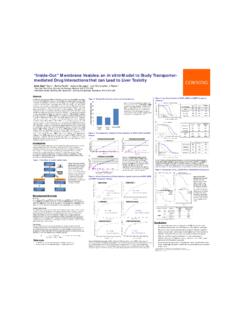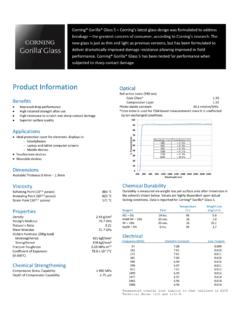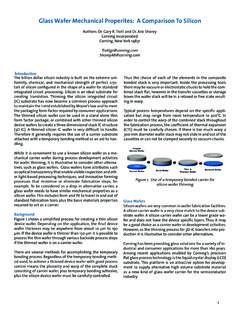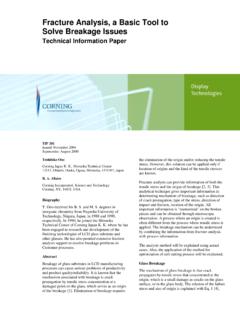Transcription of Corning Filtration Guide
1 Corning Filtration GuideInnovative Products for Filtration and UltrafiltrationTable of ContentsFiltrationSelecting the Best Filter for Your Application .. 1 Improving Filter Performance .. 5 Spin-X Tube Purification of DNA from Agarose Gels .. 6 Safety Precautions .. 7 Bibliography .. 7 Ordering Information .. 8 Ultrafiltration .. 12 Introduction .. 12 Choosing the Right Concentrator Doesn t Have to be Complicated .. 12 Choosing the Best Molecular Weight Cut-off Membrane .. 14 Helpful Hints .. 14 Chemical Compatibility .. 15 Ordering Information .. 161 FILTRATIONS electing the Best Filter for Your ApplicationChoosing a filter does not have to be complicated Corning has simplified the process. Just follow these four easy steps:Step 1: Match your application with the appropriate pore 2: Select the membrane and housing material for your 3: Select the correct membrane area to optimize flow rate and 4: Choose the best filter design for your 1: Match your application with the pore pore size is usually determined by your application or objective.
2 Mycoplasma removal can be performed using a m pore filter. Routine labora tory sterilization of most media, buffers, biological fluids and gases is usually done with or m pore filter membranes. Clarification and prefiltration of solutions and solvents is best accomplished with m or larger filter membranes. Prefiltration to improve filter performance can also be accomplished by the use of glass fiber prefilters that can be purchased separately. Use Table 1 to match your applications with a recommended membrane and pore 1. Selecting the Pore SizeApplication Pore Size ( m) Membrane Availability Mycoplasma Removal PESS terilization and Ultracleaning to All membranes except PTFE of Aqueous Solutions Ultracleaning of Solvents (HPLC) to RC, nylon, and PTFE Clarification of Aqueous Solutions All membranes except PTFEC larification of Solvents (HPLC) RC, nylon, and PTFEC oarse Particle Removal SFCA, glass fiber prefilters PES = polyethersulfone, PTFE = polytetrafluorethylene; RC = regenerated cellulose; SFCA = surfactant-free cellulose 2: Select the membrane and housing material for your Filter Membranes Your filter unit must be fully compatible with the chemical characteristics of your sample.
3 Some filter membranes contain non-toxic wetting agents that may interfere with some applications. Other membranes may bind proteins or other macromolecules leading to premature filter clogging or loss of valuable samples. Therefore, it is very important to understand their char acteristics and the potential effects filter membranes can have on the solutions they information from Tables 2 and 3 will help you choose the appropriate Corning membranes for your 2. Characteristics of Corning Filter MembranesMembrane Cellulose Cellulose Polyether- Regenerated Material Nitrate Acetate Nylon sulfone Cellulose PTFE Wetting Yes Yes No, naturally No Yes Does Agents hydrophilic not wet Protein Very high Very low Low to Very low Low N/A Binding moderateDNA High Very low Very high Very low Low N/A Binding Chemical Low Low Moderate Low Very Very Resistance to high high highPTFE = acetate (CA) membranes have a very low binding affinity for most macromolecules and are especially recommended for applications requiring low protein binding, such as filtering culture media containing sera.
4 However, both cellulose acetate and cellulose nitrate membranes are naturally hydrophobic and have small amounts (less than 1%) of non-toxic wetting agents added during manufacture to ensure proper wetting of the membrane. If desired, these agents can be easily removed prior to use by filtering a small amount of warm purified water through the membrane or filter unit. Surfactant-free cellulose acetate membranes with very low levels of extractables are available on some Corning syringe nitrate (CN) membranes are recommended for filtering solutions where protein binding is not a concern. They are recommended for use in general laboratory applications such as buffer Filtration . Corning s cellulose nitrate membranes are Triton X-100-free and membranes are naturally hydrophilic and are recommended for applications requiring very low extractables since they do not contain any wetting agents, detergents or surfactants.
5 Their greater chemical resistance makes them better for filtering more aggressive solutions, such as alcohols and DMSO. However, like cellulose nitrate membranes, they may bind greater amounts of proteins and other macromolecules than do the cellulose acetate or PES membranes. They are recommended for filtering protein-free culture (PES) membranes are recommended for filtering cell culture media. PES has both very low protein binding and extractables. PES also demonstrates faster flow rates than cellulosic or nylon membranes. Regenerated cellulose (RC) membranes are hydrophilic and have very good chemical resistance to solvents, including DMSO. They are used to ultraclean and de-gas solvents and mobile phases used in HPLC (PTFE) membranes are naturally and permanently hydro phobic. They are ideal for filtering gases, including humidified air.
6 The extreme chemical resistance of PTFE membranes makes them very useful for filtering solvents or other aggressive chemicals for which other membranes are unsuitable. Because of their hydro phobicity, PTFE membranes must be prewetted with a solvent, such as ethanol, before aqueous solutions can be fiber filters are used as a depth filter for prefiltration of solutions. They have very high particle loading capacity and are ideal for prefiltering dirty solutions and difficult-to-filter biological fluids, such as Filter Housing MaterialsThe filter housing materials, as well as the filter membrane must be compatible with the solutions being (PS) is used in the filter funnels and storage bottles for the Corning plastic vacuum filters. This plastic polymer should only be used in filtering and storing nonaggressive aqueous solutions and biological fluids.
7 Refer to Table 3 for more chemical compatibility copolymer (AC) and Polyvinyl chloride (PVC) are used in some of the Corning syringe filter housings. These plastics should only be used in filtering nonaggressive aqueous solutions and biological fluids. Refer to Table 3 for more chemical compatibility (PP) is used in the Spin-X centrifuge filters and some of the syringe and disc filter housings. This plastic polymer has very good resistance to many solvents, refer to Table 3 for more chemical compatibility CompatibilityThe mechanical strength, color, appearance, and dimensional stability of Corning filters are affected to varying degrees by the chemicals with which they come into contact. Specific operating conditions, especially temperature and length of exposure, will also affect their chemical resistance.
8 Table 3 provides a general guideline for the chemical resistance of Corning filter membranes and 3. Chemical Resistance Guide for Corning Filters* Filter Membrane Housing Material Chemical Class CN CA NY PES RC PTFE PS PP AC PYR Weak Acids 2 2 2 1 1 1 1 1 2 1 Strong Acids 3 3 3 1 3 1 2 1 3 2 Alcohols 3 1 1 1 1 1 2 1 3 1 Aldehydes 2 3 2 3 2 1 3 1 3 1
9 Aliphatic Amines 3 3 1 1 1 1 3 1 3 1 Aromatic Amines 3 3 2 3 1 1 3 1 3 1 Bases 3 3 2 1 2 1 1 1 2 2 Esters 3 3 1 3 1 1 3 2 2 1 Hydrocarbons 2 2 2 3 1 1 3 2 2 1 Ketones 3 3 2 3 1 1 3 2 3 11 = Recommended; 2 = May be suitable for some applications, a trial run is recommended; 3 = Not recommended; AC = acrylic copolymer; CA = cellulose acetate; CN = cellulose nitrate; NY = nylon; PES = polyethersulfone; PP = polypropylene; PS = polystyrene; PTFE = polytetrafluorethylene; PVC = polyvinylchlorides; PYR = PYREX glass; RC = regenerated cellulose.
10 * This information has been developed from a combination of laboratory tests, technical publications, or material suppliers. Due to conditions outside of Corning s control, such as variability in temperatures, concentrations, duration of exposure and storage conditions, no warranty is given or is to be implied with respect to this 3: Select the correct membrane area to optimize flow rate and a filter that will have enough volume capacity or throughput to process your entire sample quickly and efficiently. This is primarily determined by the effective surface area of the membrane. Table 4 shows the relationship between filter size, effective Filtration surface area and expected throughput volumes. The lower values are typical of viscous or particle-laden solutions; the higher values are typical of buffers or serum-free 4.









